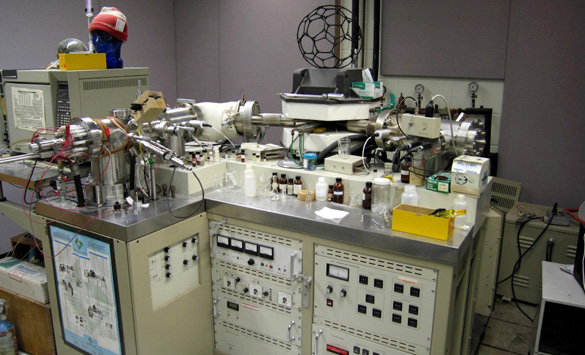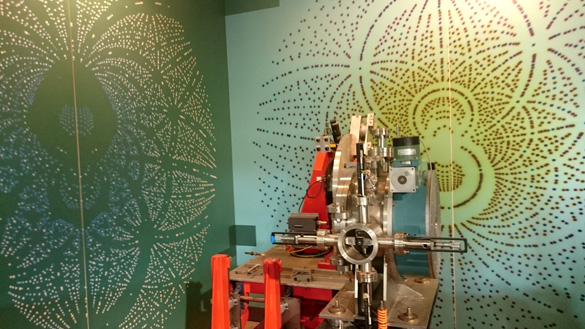
1. Introduction
In the recent world of fringe science, there has been an explosion of interest in so-called meta-materials allegedly “recovered from unidentified aerial phenomena.” Although this announcement has created a great deal of excitement, there has been very little context to these claims. The public, therefore, has no real baseline by which to critique or even understand the claims or methods being employed to confirm the potentially anomalous nature of the material. For example, how can a member of the public understand whether or not the testing methods suggested by a variety of individuals are sufficient? And how will the evidence such testing provides be understood and analyzed by the scientific community, and how best can that be expressed to the general public? In this report our group will give this context, helping the public to construct informed opinions on these testing methods, results, and the very nature of the tests performed.
As a first pass on this analysis, we must understand what questions are being asked. In other words, let’s suppose we were given a piece of material that was believed to have come from another, potentially alien civilization. The challenge presented to our scientific team is to prove whether or not this material really did, or at least most likely must have, come from some non-Earth intelligence. How would we begin to develop a plan to test if the evidence supported this hypothesis? This question can be broken down into a number of significant portions. Firstly, we would want to identify if the material has come from outer space by comparing it to similar materials or samples we find on Earth. Does it show significant enough differences to cause us to believe it did not come from our planet? Second, is there evidence that the material has been engineered or designed in some way? Does it show properties or applications that we wouldn’t expect to occur naturally, or is it engineered or composed in a way to give it specific properties? And third, does it show advanced techniques or knowledge with which we are unfamiliar. Are there super-heavy elements which we have yet to discover here on Earth, does it show crystal structures or solid phases that have not yet been documented by the materials science community, does it show composition and engineering which is beyond the scope of science today?

If these three questions are answered in the affirmative and supported by evidence this would be enough to support the hypothesis. This would show that this material is not only from outer space but from a civilization that had engineered it for a specific purpose. Each question answered in the affirmative would be a tremendous milestone for the person who found the material, but not enough to support the extraordinary claim of alien engineering on its own. For instance, if the material were found to be from outer space with evidence of unknown properties it may be a meteorite or other piece of space debris, but not necessarily from another civilization. At the same time, if the material showed evidence of engineering and was also found to have unknown properties it could be from an experimental aircraft or another device that is currently unknown to the public and scientific community. One possibility we cannot ignore here is that our current science may not be able to understand or determine the properties or applications for which a given material has been engineered. This may give a false negative to our question 3 above and lead us to unfairly characterize some samples as not passing the high threshold we have set. Ultimately if a material has been engineered, it is almost implied that there would be a reasoning behind this engineering, some application for which it would be used. Therefore, I would anticipate that although we may not currently understand its application that does not imply that an application was not in mind when the material was initially designed. This suggests that for cases where engineering is suspected as well as a non-Earth point of origin careful consideration must be given to potential applications we do not expect, as well as a variety of tests that may not be obvious to the engineer or scientist.
Materials science is a broad field with applications across the breadth of scientific, engineering, and medical studies. It deals primarily with the analysis and study of solid materials, both in their bulk form (for example the properties of a gallon of sand) and at the level of individual particles (a single grain of sand). This science deals with both crystalline materials, those with repeating patterns of atomic arrangement into what are known as crystalline phases (one of the most well-known examples of a crystalline solid is diamond, although crystals do not need to be gem-like, for example, salt), and amorphous solids, those without repeating atomic arrangements (one of which is aluminosilicate glass materials such as those used for dishware or windows in homes). Other materials which are well known to the reader are metallic solids such as Iron (a bulk collection of iron atoms held together by shared electrons) and steel (an alloy of iron with other metals, creating a solid mixture of components into a roughly homogeneous material). These materials are all, more or less, simplistic in their composition and manufacturing processes. For the majority of our time as a civilization, we have either mined them from the Earth for our direct use, or performed slight modifications such as melting, remixing, and re-casting to make them more useful. It is potentially true that other civilizations, having obtained the ability to make their way to our distant corner of the universe, will have also had their bronze or iron ages far in the past, and come to roughly the same conclusions as our metallurgists, scientists, and engineers when it comes to how to shape and utilize these materials at the bulk scale (assuming of course that these beings are physical things at all, something that is out of the scope of this discussion).
In recent years, materials engineering has focused on the creation of novel materials for directed applications. In particular, this has focused on the creation of materials with nanoscale properties, those which become apparent at the bulk scale but are due to properties of the material at the scale of 1 x 10-9 meters long. Of particular interest to the study of potentially engineered materials, the behavior of nanoengineered solids is such that they would not, in general, be possible in nature as far as we understand it. These may include the creation of composite materials (e.g. solid particles covered in polymer molecules, layers of unlike oxides and metallic compounds with polymer or soft matter layers, designed or engineering crystal or polymer phases, and others), the creation of non-standard geometries (asymmetrical crystal growth or properties, designed crystal defects at regular positions, pillaring or other mixed porosity structuring), or the creation of materials that are post-synthetically functional (in other words materials that can be reversibly altered through the application of heat, chemical impulse, electromagnetic field, or some other energy/force). Probing structures of this sort is a complicated process, but one which has a tremendous amount of literature background available for the interested scientist or engineer. The pathway is apparent to those with the wherewithal to follow it; however, the jargon and specifics may be confusing and difficult to the interested public. In general, however, there are a number of properties that would be of immediate interest to a material scientist faced with the three hypotheses we have posited above.
2. Atomic and Isotopic Make-Up
The first piece of useful information is what the material is composed of. This question in the first place helps to narrow down our later searches significantly, provides information to hint at the origin point of the material, and may even help us answer if the material has been engineered or not; as has been gone over consistently in the popular articles on this subject one of these tests would include something like EDS (Energy-Dispersive X-Ray Spectroscopy) or XRF (X-ray Fluorescence). In both of these tests, a material sample is bombarded with X-Rays in a test chamber, causing the atoms within the sample to become excited. These excited atoms eventually relax back to their initial ground state, by releasing photons which are then collected by a detector within the test chamber. The released photons are dependent on the atomic number of the elements within the sample, and in some testing methods, the oxidation state of the atoms within the material can be determined as well. These tests provide information on the elements within the sample, as well as a rough estimate of the chemical makeup of the bulk solid. In the unlikely case that the material contains an unknown element, it is these sorts of tests that would show the scientist that further testing should likely be performed. These tests may also suggest the presence of elements we don’t expect to find normally on the surface of the Earth, or even percentages of elements that are uncommonly found. For example, there are elements which are not naturally occurring but instead result from our nuclear weapons testing. Elements of this sort such as Strontium and Cesium would not be anticipated in high percentages in a normal sample of material, although again this would only suggest that the material is not from a standard source and not that it is extraterrestrial in origin.
Another type of information which has been held up as the holy grail of material testing in pop science is isotopic testing and ratio analysis. Isotopes of a given element are defined by their atomic number (the number of protons in their nucleus, which gives the element it’s identity and placement on the periodic table) and their mass (the number of protons and neutrons, each defined as one atomic mass unit, within the nucleus). The relative abundance of an isotope of an element on the surface of the Earth is, very roughly, averaged to give the atomic mass listed on the periodic table for that element. Isotopes vary due to their stability (with radioactive isotopes decaying and therefore becoming less abundant with time), and therefore the relative ratio of isotopes within a given sample would normally be expected to fit within the range of other samples found on the Earth. However, the variation of isotopes across the Earth’s surface can vary significantly, with radioactive testing and other geological or historical factors potentially playing a part. Therefore, it is important to be nuanced and careful in the analysis of these tests, a fact that has not been fully appreciated to date by those claiming to have extraordinary samples. At best isotopic testing would tell us that material is outside of the range of terrestrial samples we usually find, warranting further study by other means. It may also tell us if the sample is from before or after the Earth or even our solar system formed, or what local chemical or geological make up may have looked like over the lifetime of the sample. However, isotopic testing alone is not sufficient to answer the question of whether or not a sample has been engineered or left behind by some advanced civilization.
Isotopic testing is generally performed utilizing magnetic mass spectrometry techniques such as Isotope-Ratio Mass Spectrometry (IRMS) or Inductively Coupled Plasma Mass Spectrometry (ICPMS). In these tests, the material sample is first atomized, either by grinding or very fast heating and dispersion in a carrier solution, which also causes them to take on a net positive or negative charge and thereby become ions. These ions are then carried with the carrier gas or plasma through a magnetic field towards an ion detector. The magnetic field is set up in such a way that ions will be separated from one another based on their mass to charge ratio, a value which is specific to ions of isotopes of a given element. Essentially, isotopes which are heavier will flow more slowly with the carrier gas, and those with higher charges will be more attracted to the magnetic field. This allows us to obtain a readout of the mass to charge ratio of the atoms within a sample, which when compared to a standard set of samples can then be used to determine the isotopes within the sample as well as their relative abundance based on the number of hits the detector reads. The results of these tests can be extremely accurate, down to parts per million of a sample if given the correct calibrations and analysis methods being employed.

3. Crystallography and Surface Characterization
If an advanced civilization has engineered a material for a specific purpose, one of the avenues to discover the trademarks of this engineering may be in the specifics of the solid components that make up the material. This includes the surface characteristics of the individual solid components (for example are they patterned or etched, do they show evidence of atomic deposition or other surface treatments for growth or sealing, are the surfaces polished or show a lack of imperfections), the porous structure of the support (is the surface area very high, are their complex porous channels that appear to have some separation or adsorption potential, are the pores engineered to include secondary chemical sites for chemisorption or catalysis of some sort), the crystal structure or phase of the components (is it a crystal structure that currently exists on Earth, is it a single crystal compound, does it show multiple materials combined together in a way which is unexpected), and the bulk properties of the solid (how does it respond to temperature, pressure, shear stresses, radiation, etc). The range of possible properties that can be probed in this case is vast; however, there are a few tests which I would consider to be absolutely necessary for a true analysis of any potentially engineered solid. These include X-Ray Diffraction, Pore/Surface analysis via adsorption isotherm, Raman or FTIR Spectroscopy, Electron Microscopy, and Thermogravimetric Analysis/Differential Scanning Calorimetry. These cover the broad gamut of materials characterization, giving a view of the materials properties as they currently exist, and would hint at potential other applications or methods of engineering should they exist.
X-Ray Diffraction consists of the analysis of how an X-Ray beam is diffracted off of a materials crystal lattice. You can imagine a crystal structure like a regularly repeating pattern of atoms, each placed in a fixed position to one another in 3-dimensional space. During X-Ray diffraction, the crystal lattice is bombarded with photons, which are being shot as a beam at a given angle. Photons will interact and collide with atoms within the crystal lattice if they come into contact and be diffracted off of the solids lattice. In X-Ray Diffraction the photons that are diffracted are collected at each given angle and analyzed to determine information about the geometry of the crystal structure, how well defined the crystal is, and even in some cases how much stress or strain the material is under. For our analysis, the first important characterization is if the material is a crystal structure or not. If it is a crystal, is it a sort of crystal structure that we would find in the scientific literature, or is it something novel to materials science? From the hints that we have received so far by those in possession of these materials, we may expect that the solid is layered, or lamellar. These layered solids possess diffraction patterns at the lowest X-Ray angles, between 0.1 and 5 degrees 2 theta (2 thetas being the measured angle of the X-Ray beam). This corresponds to very large spaces between repeating planes, with most layered materials in the open literature showing d spacings of between 10 and 40 Angstroms. This would be a quick and easy test to run and would immediately tell us if the structure is layered in any way which would make it outside of the scope of naturally occurring lamellar structures such as clays or layered hydroxides.

Spectroscopy occurs similarly, probing the structure with photons of a given energy and observing the excitation of the material surface to tell us something about the chemical bonds likely present on the material. Raman spectroscopy is generally utilized in this field for metallic structures, although the information obtained in this way is generally limited. The true use of these spectroscopic techniques from a materials science perspective is in the ability to see if there are secondary chemical functionalities present on the material’s surface. For example, we may expect that catalysis or separation applications on some other planet would require the same careful control of chemical binding sites as we use on Earth for our catalysis and separations applications. This would be clear by the presence of secondary chemical species not often found on the surface of solid materials. Sensors on a material surface, coatings for different applications, and other potential surface species adsorbed onto the material being studied (such as debris from entry into the upper atmosphere, chemical species from the atmosphere of where ever this material has been, and other surface alterations) would also potentially be observable from such an analysis. This in tandem with isotherm analysis for porosity and surface area information would also be extremely useful. Materials with very high surface areas may show potential as catalysts or adsorbents and would show at least that the material was likely created and not naturally occurring (surface areas as high as 3000 m2/g have been achieved on Earth, although only for synthetic materials).
Electron Microscopy via Scanning Electron Microscopy and Transmission Electron Microscopy would give information as to the solids bulk surface properties, although outside of that the information gleaned from such analysis is likely to be limited. Of particular interest would be whether the surface is patterned or altered in some way. For example, on Earth we are currently studying the effect of rough surface patterning on anti-bacterial or microbial properties of surfaces, as well as what effect surface etching or patterning can have on the ability to repel or absorb water. We may expect that other intelligences would also find these properties useful to tune and would utilize them to provide beneficial properties to their materials. There may also be other surface patterning alterations which provide additional benefits, for example, radar cloaking or resistance to heat or radiation. On top of that if the material has been fabricated at the micron or bulk scales, then these microscopic techniques would tell that story, providing direct evidence of engineering. Thermal analysis may also provide some benefit, although this would again be limited. TGA and DSC work by heating the material slowly over time and observing what changes are made to the temperature of the material or the weight of the material. This may provide information on organic content, the ability of the material to withstand increased temperatures or heat fluxes, and how the solid behaves under the extreme heat of entry into the atmosphere from space.
4. Current State of Materials Study and Conclusion
As far as can be gleaned from the information available to the general public, it appears that efforts to date concerning the analysis of solids potentially occurring from some unknown civilization have focused on the first class of studies, those concerning the elements making up the material and their isotopes. However, as has been suggested by this work that is only a small portion of the entire picture needed before any definitive conclusions can be made. There are other, more specific tests that would need to be run to determine the potential applications of any material, how it was potentially fabricated, and where it may have come from. However, as any first-year materials science student can tell you, these are the basic analytical techniques which would be utilized for a serious investigation. Of particular concern to the interested public should be any study that purports to give evidence without reporting clearly and in detail their methods, potential sources of error, the accuracy of their measurements, and other information required to replicate their results. Without these pieces of information, it is impossible to verify any claims regarding a material’s properties, let alone more extraordinary claims regarding potential engineering by a non-Earth civilization. It is the authors hope that this report has been informative to the general public, and it is our sincere hope that this work may be of some use to those interested in these subjects who are not sure what to make of extraordinary claims of materials with special properties or exotic origin points.
Prepared by Christopher F. Cogswell, Ph.D. in association with the Scientific Association for the Investigation of Unexplained Phenomena.







Nasa scientist Silvano P. Colombano states that aliens might already have found us.
https://everydayscience.blog/nasa-scientist-silvano-p-colombano-says-that-the-aliens-were-already-with-us/